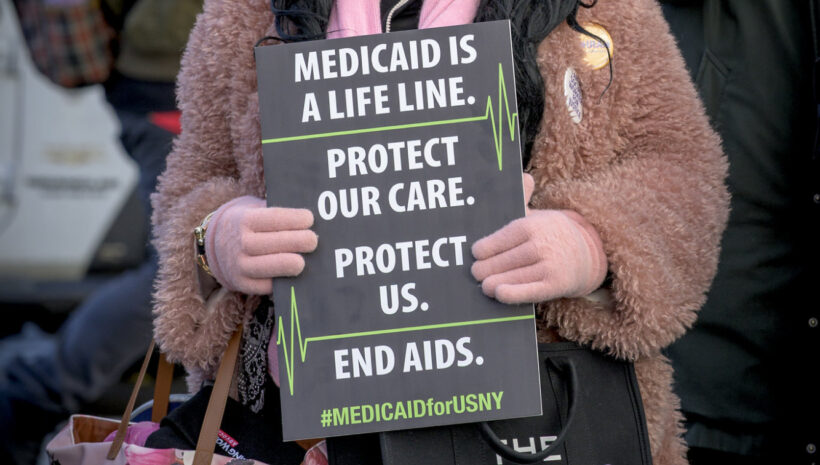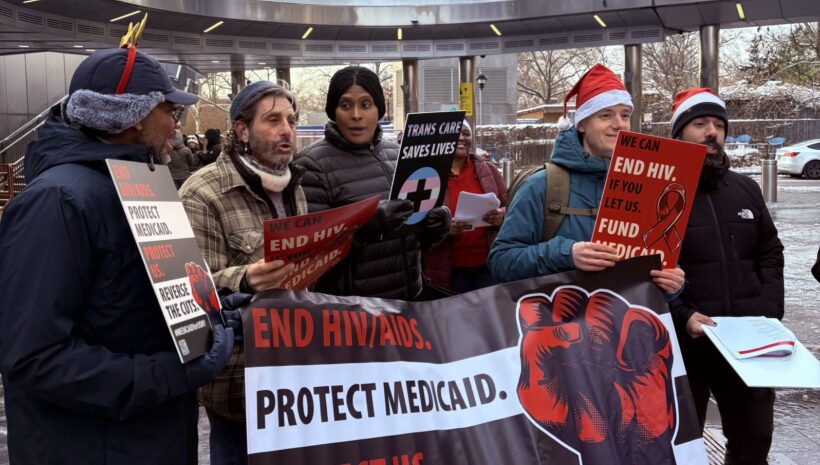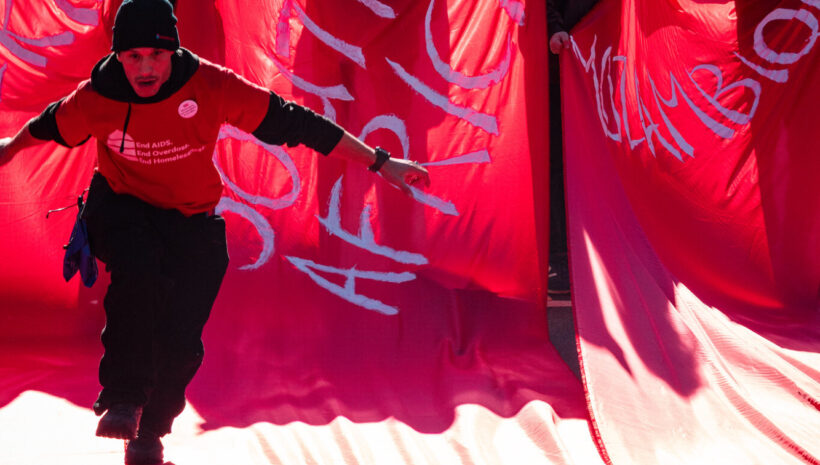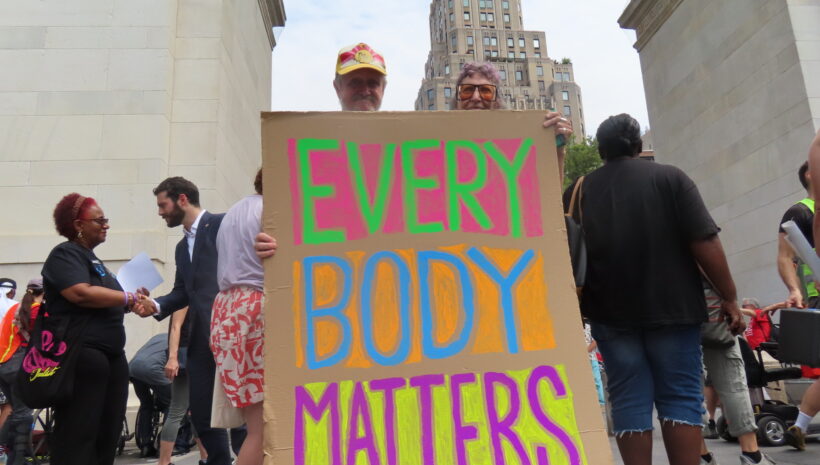Last week, Housing Works’ vice president for national advocacy and organizing Christine Campbell had a report for you from the big HIV/AIDS Housing Summit in Montreal. Our cofounder and CEO Charles King gave an address there, about taking on the big picture of human rights in order to end the AIDS epidemic once and for all, which brought many in the room to tears. We reprint it in full below.
Ending the AIDS Epidemic in New York State and Around the Globe
Presentation by Charles King
North American Housing and HIV/AIDS Research Summit VII
26 September, 2013, Montreal, Canada
Eight years ago, Housing Works facilitated the organization of a network of AIDS activists called the Campaign to End AIDS. That year, I was privileged to visit some 85 towns and cities in 35 states and territories of the United States, calling for collective national advocacy toward ending the AIDS epidemic in the US and the AIDS pandemic around the globe.
Over and over again, in churches, community centers, university halls, and public parks, I gave the same speech. “Even without a vaccine or a cure, we have in our hands right now the tools to end AIDS as an epidemic,” I would say. “Moreover, living in the wealthiest nation in the history of the world, it is not a lack of resources that is keeping us from ending the epidemic. It is a lack of political will.”
Well, over the subsequent 8 years, considerable research has come to the fore that supports all of the arguments we were making back then. On the biomedical side, we have continued to see improvement in ARVs, including a single daily pill. And we are on the verge of a single monthly injection. We have moved to recommend earlier and earlier treatment. Also, we have learned that viral suppression is more effective than condom use in preventing transmission, and we have seen proof that both post exposure prophylaxis for voluntary sexual exposure and pre-exposure prophylaxis can be effective as prevention tools, particularly if used in targeted and strategic ways.
On the bio-social side, evidence has been piling up that the epidemic has largely been driven into certain key populations, primarily low income women and girls, female and male sex workers, transgender individuals, men who have sex with men, injection drug users, homeless people and prisoners. Moreover, we have learned that predictors of risk among these populations have less to do with specific individual behaviors and autonomous decisions than with social drivers that shape and constrain individual behaviors – increasing HIV exposure and limiting treatment access and effectiveness. Thus there is a general understanding, if not a consensus, that structural interventions that address homelessness, food insecurity, as well as other social and economic inequities and stigma and discrimination are essential to ending the pandemic.
Even as our knowledge and tool kit are expanding, we have begun to see significant results in the aggregate and in pockets around the globe. Just this week, UNAIDS released a report that last year the world saw 20% fewer infections last year than in 2001, and a much more dramatic reduction in peri-natal transmission, over 50%. Globally, AIDS-related deaths are down 24% just from 2005, corresponding with a dramatic increase in the number of people living with HIV who are now receiving ARV’s.
In well-resourced settings, we are seeing even more dramatic gains than these global advances. Places like San Francisco, Massachusetts and New York State are achieving remarkable success, such that in New York we have an estimated viral suppression in excess of 40% compared to 25% viral suppression nationally. But it is important to note that these gains are not necessarily secure. Nor does all of our increased knowledge and enhancement of the tool box mean that the curve will inevitably continue to bend toward ending the epidemic.
In fact, our progress is placed at risk by our success. In New York, our success has meant fewer federal dollars directed toward AIDS as the epidemic continues to grow more rapidly in other parts of the country. And last year, the Governor’s proposed budget called for a significant cutback in State tax levy dollars dedicated to the AIDS response, as well as a reduction in the independence of our state AIDS Institute. Our current US National AIDS Strategy at its most ambitious is really about maintaining what we have now – a stable epidemic.
There are two problems with a stable epidemic, the first being that it rarely remains stable. What we have seen in places like Uganda, Thailand and even within the European Union is that if you don’t keep the curve going down, a single change in policy, loss of focus or even just complacency inevitably results in a resurgence that is far harder to contain than the original epidemic. The second problem is the sheer growth in cost. The United States has been stable at about 50,000 new infections a year for the last decade. In ARV treatment terms alone, that means the national cost of AIDS grows by some $500 million a year. At some point, even a stable epidemic that remains stable becomes too expensive to afford, certainly on a global scale.
So we are at this remarkable moment where we indeed have the tools to end the epidemic and in which we have a very short window of time to galvanize the public imagination sufficient to secure the political capital necessary to bring the epidemic to an end. And on that note, I am pleased to report that I have been a part of two conversations, one in New York State, and the other on the global level, taking seriously the challenge of bringing the AIDS epidemic to an end.
The New York effort began with a couple of think tanks organized by the community, but with participation particularly by key state policy makers such as Jason Helgerson, our state Medicaid Director and Dan O’Connell, the acting Executive Director of the NYS AIDS Institute. The threat to the independence of the AIDS Institute became an opportunity that people like Dan Tietz from ACRIA capitalized on to galvanize the AIDS community, and we are now in serious conversation with the Governor’s office about Governor Andrew Cuomo using his State of the State address to announce the formation of a taskforce that follows the path laid out by the Medicaid Redesign Taskforce, that Jason talked about this morning, to bring an end to AIDS as an epidemic in the next five to ten years. In fact, we are working with the AIDS Institute to establish a shadow Taskforce to begin laying the ground work for that announcement.
The global conversation is being driven by the end of the timeframe for the United Nations’ Millennial Development Goals, 2015, and the process for developing the United Nation’s Post-2015 Development Goals. Under the MDG’s, AIDS has its own goals, that were established at two different General Assembly Special Sessions on AIDS. AIDS is now being folded into the health goals, and there has been tremendous fear that it would lose its place as a global priority. Both as a political strategy and to capitalize on the moment within which we stand, Michel Sidibé, the Executive Director of UNAIDS, has moved toward setting a goal of ending the global epidemic by 2030.
There are many complicated processes around the development and adoption of the Post-2015 Development Goals. But what is most important for you to know is that UNAIDS has joined forces with the medical journal the Lancet to organize the UNAIDS and Lancet Commission on AIDS and Sustainable Health. This commission is developing a report that will be published in June 2014. This report will call for ending the AIDS epidemic by 2030 and spell out a roadmap for doing so. This report will be UNAIDS’ principal vehicle for positioning AIDS in the Post-2015 agenda.
In both of these processes, the first step is defining what we mean by ending the epidemic. As David Holtgrave said yesterday, a nomenclature already exists for this conversation, with control as the first level, meaning a low endemicity of, say, .5% incidence, not just on some overall average, but within every sub and sub, sub, sub population and strong maintenance efforts to avert even small outbreaks and resurgence. The next level is elimination, meaning close to zero new infections, which, if we could get the incidence down, we could achieve even with current technology, through multiple layers of only partially effective prevention and even a 30 to 50% effective vaccine. The third level is eradication, something that would be impossible to achieve without both a strong vaccine and a cure, and even then, as David Holtgrave pointed out, might not be deemed cost effective in light of the required additional investment once you get to elimination.
The next step is setting measurable bench marks and strategies for reaching those bench marks. The fact is that these strategies will not be cost-free. In fact, they will call for significant new investment, with the promise of averting significant costs in the future. In New York, we are counting on two sources to fund this initiative in addition to additional tax levy dollars. One of these is savings from Medicaid spending that Jason described briefly this morning. The second is negotiating a new ARV-pricing structure that promises significant new volume for significant discounts.
On a global level, this will only be achieved with significant increases in contributions from donor nations, coupled with continued reductions in ARV costs for low and middle income countries, or, even better, a global financial transactions tax, sometimes called the Robin Hood tax, coupled with a global essential drugs treaty that funds research and development instead of relying on a global capitalist economy to marshal the resources.
I’ve taken the time to briefly outline both of these agendas for you so that you understand their real potential both as truly achievable and as an agenda that can capture the imagination of researchers, policy-makers, the AIDS community and the public at large, such that we create the political capital to make the investments that will be required to achieve the goal of ending AIDS.
But now to the heart of my presentation in the few minutes I have remaining. The fact of the matter is that, without a strong vaccine and a cure, you cannot end the AIDS epidemic without bringing to bear structural interventions that address the social drivers of disease, particularly given that the virus is most persistent in populations that are already deeply marginalized by society and consequently experience tremendous social and economic inequalities. These interventions are all the things we have been talking about over the last two days, housing, food security, and the other basic necessities that facilitate things like retention in care and medication adherence. For drug users it requires clean syringe access and other evidence-based harm reduction interventions.
These structural interventions must necessarily be rooted in human rights, a topic we heard about yesterday, particularly addressing laws and cultural norms that facilitate gender inequality as well as stigma and discrimination. The latter includes repeal of laws that criminalize HIV, sex work, and drug use, as well as laws and social norms that perpetuate homophobia and discrimination against transgender people. Our movement and our summits have to broaden beyond housing to achieve an entire architecture that recognizes the humanity and fundamental rights of even the most marginalized members of our society.
NAHC and OHTN are partnering with UNAIDS and the World Bank to hold a small convening this coming January that is intended to flesh out what this means on a global level. Our hope is that the report out of this convening will be incorporated into the Lancet Commission process and be the launch of a global campaign to interject structural interventions like housing into the global AIDS response. Rather than taking more of your time today, let me conclude by sharing with you an statement (?) I made two weeks ago at a round table on the End of AIDS convened by UNAIDS:
I salute Michel [Sidibé] for having changed the paradigm by insisting that we look toward an end of AIDS. I was in a meeting with him this June, when he said, “If Jim Kim [head of the World Bank] can have the audacity to call for an end to poverty by 2030, then I would be a coward not to call for an end of AIDS in that same time.” With that remark, he suggested a second major paradigm shift in as much as those two goals are not unrelated.
For too many years, we have insisted on treating HIV as a biomedical event, when in fact it is a biosocial phenomenon. That is to say, that while HIV is indeed a virus, it is a virus that is driven, as we all know, by social violence, which is why it largely has spread through the most socially and economically marginalized members of our communities and wrecks even more poverty and marginalization in its wake, at a very great cost.
We pay lip service to this phenomenon through our talk of key populations. But we persist in largely biomedical and individualistic behavioral responses. In order to end the epidemic, with or without a vaccine, we need structural interventions that address the social drivers of this disease. To date, with the exception of vulnerable children and orphans, and pieties about human rights, we have resisted this approach both because of the attenuated nature of the causal links and because of the supposed financial or political cost of the required interventions.
In fact, we have to recognize that these key populations represent the nexus between the goals of ending poverty and ending AIDS. It is not so much new money we need. It is targeting our development dollars at the right people, both to eliminate poverty and to stop transmission of the virus, and taking seriously the commitment to human rights. Structural interventions, properly applied, can serve not only to keep millions of HIV+ people in care and ultimately virally suppressed, but they are also an effective prevention strategy.
I believe I am on solid scientific and economic ground for my case, being neither a scientist nor an economist. But the Baptist preacher requires me to speak not just of science and economics, but also to the human condition. You see, when I speak of the cost of social violence, I am not just speaking of the economic cost or the disease burden.
Think about what it means to be subjected to social violence. Homelessness not only deprives you of the means to organize your existence, it deprives you of your very dignity.
Not being able to feed your children not only deprives them of essential nutrition, it signals that you are not fit to be a mother.
Being unable to get a job because you are an obviously gay man or a transgender woman not only deprives you of a livelihood, it says you have no value to offer society.
Hiding from punitive laws because you are addicted to drugs or survive by selling sex not only forces you underground, it destroys your sense of self worth.
We talk about living well as both a measure of disease control and of economic development. But social violence not only spreads HIV and poverty, it destroys one’s soul. We will not end the devastation of AIDS until we allow those who have been impacted to reclaim their most sacred part, their very souls.
That is what ending AIDS is most about. Not just stopping a virus, but allowing people who have been cast to the margins to reclaim their place in our communities and in the world. Thank you.




